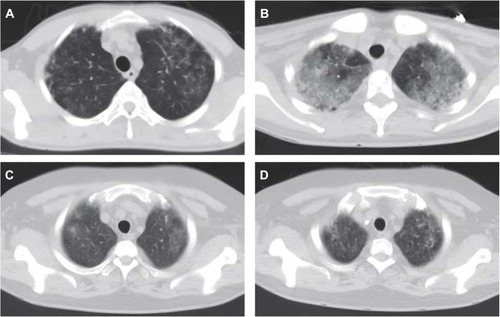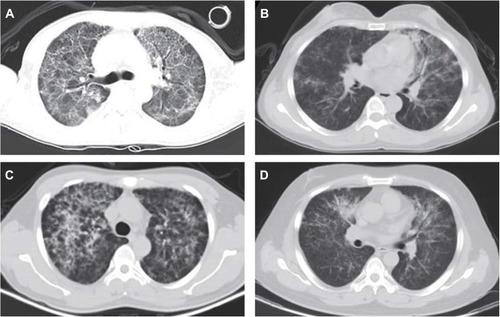Figures & data
Table 1 Demographic Characteristics, Symptoms, Auxiliary Examination, and Treatment of 24 Patients with PCP After RT
Figure 1 Computed tomography (CT) showed ground-glass opacities in the apexes of both lungs in the initial phase of Pneumocystis pneumonia (PCP). (A) A 31-year-old male patient underwent parental-origin renal transplantation (RT) after 3 years of hemodialysis, and PCP occurred 7 months after RT. In the early stages, CT showed ground-glass opacities in the apexes of both lungs. (B) A 37-year-old female patient underwent RT after 8 years of hemodialysis, and PCP occurred 3 months after surgery. CT showed a decrease in the transmittance of the two lungs, and diffuse, plaque-like, and strip-like opacities were seen in both apexes. (C) A 30-year-old male patient underwent RT after 1 year of hemodialysis, and PCP occurred 3 months after RT. CT showed increased clouding and ground-glass opacities in the apexes of both lungs, and the edges were unclear. (D) A 39-year-old male patient underwent RT after 5 years of hemodialysis, and PCP occurred 3 months after surgery. CT showed ground-glass and strip-like, high-density shadows scattered across the apexes of both lungs.

Figure 2 Lung CT showed diffuse, plaque-like, ground-glass opacities in both lungs. (A) A 37-year-old male patient underwent RT after 4 years of hemodialysis, and PCP occurred 4 months after surgery. CT showed plaque-like, grid-like, high-density shadows and clouding in both lung fields, with blurred edges. (B) A 40-year-old female patient underwent RT after 1 year of peritoneal dialysis, and PCP occurred 5 months after surgery. CT showed increased multiple plaque-like opacities in the lungs, and the edges were unclear. (C) A 36-year-old male patient underwent RT after 1 year of hemodialysis, and PCP occurred 3 months after surgery. CT showed diffuse, ground-glass, high-density shadows in both lungs, with unclear edges. (D) A 34-year-old male patient underwent RT after 2 years of hemodialysis, and PCP occurred 4 months after surgery. CT showed scattered, plaque-like opacities in both lungs with unclear edges.

